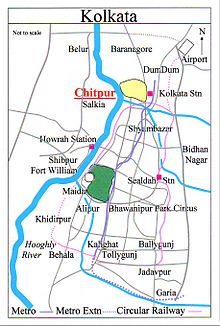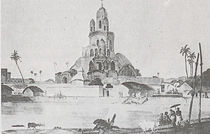- Chitpur
-
Chitpur (or Chitpore) (Bengali: চিত্পুর) is a neighbourhood in north Kolkata (formerly Calcutta) in the Indian state of West Bengal. Sometimes, the entire area along Chitpur Road is referred to as Chitpur, although the various localities have distinctive names.
Contents
History
Chitpur has existed for at least 400 years. It received its name from the goddess Chiteswari, who had a splendid temple here erected by Gobindram Mitter, where human sacrifices used to be offered. The lofty dome of the temple, which was known as Nabarutna or the shrine of nine jewels, fell during the earthquake of 1737, and it is now in ruins.[1]
According to another source, the area was earlier named Chitrapur. It is referred to in Bipradas Pipilai's poem Manasamangal in 1495, but it could be a later interpolation. According to it, Chitpur was home to Chakrapani, Commander-in-Chief of the Nawab of Bengal's army, and had a flourishing colony of artists. It refers to one Gobinda Ghosh as founder of the Chiteswari temple in 1610. The most notorious bandit of the region was Chitey Dakat, who offered human sacrifices at the temple. The area could also have acquired its name from him.[2]
It was one of the thirty-eight villages whose right to rent the English obtained from Emperor Farukshiyar in 1717. It was later reorganised as Dihi Chitpur with Chitpur, Tala, Birpara and Kalidaha villages under it.[3]
There was a house and garden of Mahmed Reza Khan, the Chitpur Nawab, to whom the administration of Bengal was assigned for several years after the British East India Company acquired the dewani of Bengal from the Mughal emperors in Delhi.[4] The Chitpur Nawab lived on terms of intimacy with the 'powers' of the day and was accounted by them as a personage of first rank. The foreign governors—Danish, French, and Dutch—on their visits to Kolkata from Serampore, Chandannagar and Chinsurah, made it a practice to halt at Chitpur on their way to the Government House.[5]
The Circular Canal joins the Hooghly River at Chitpur. Early in the twentieth century a large lock and tidal basin had been constructed, at the mouth of the canal.[4]
Entally, Manicktala, Beliaghata, Ultadanga, Chitpur, Cossipore, parts of Beniapukur, Ballygunge, Watganj and Ekbalpur, and parts of Garden Reach and Tollygunj were added to Kolkata Municipal Corporation in 1888.[6]
Chitpur Road
The great thoroughfare, which commencing in the extreme south, assumes the various names of Russa Road, Chowringhee Road, Bentick Street, Chitpore Road, and Barrackpore Trunk Road, forms a continuation of the Dum Dum Road and was the old line of communication between Morshedabad and Kalighat. It is said to occupy the site of the old road made by the Sabarna Roy Choudhurys, the old zemindars of Calcutta, from Barisha, where the junior branch resided, to Halisahar, beyond Barrackpore, which was the seat of the senior branch.[7]
H.E.A.CottonAlong that old road, popular as pilgrim's path, dharamshalas and shops came up. Habitations grew around them and localities developed. They were self-descriptive. The chicken (murgi) market (hat) was Murgihata, twin (jora) bridges (sanko) over a creek distinguished Jorasanko, butchers (kasais) slaughtered animals at Kasitola, and the potters (kumors) spun the river clay on wheels at Kumortuli. Later, they took to making clay idols in demand in the mansions that grew up all around. When the new Fort William was built in the 1750s at Gobindapur, the inhabitants of the disbanded village migrated northwards.[2]
Chitpur Road was Kolkata's oldest road. Apart from the aristocracy, there have been common folks engaged in various trades. The distinctive Bengali panjika almanac was printed here. It was a centre for Battala books. So many things on Chitpore Road have been an integral part of Bengal's life and culture – the paan (betel leaf mouth refresher), the adda (stray gossipping), jatra shows and the brass band playing "He is a jolly good fellow" to enliven wedding receptions. "Today, Biren Mondal sits making violins on the ground floor and points to the room where Michael Madhusudan Dutt lived while writing most of his best-known works including Meghnad Badh Kavya. The Mandals make and repair violins and sitars for the great. Their treasure chest holds a certificate from Yehudi Menhuin, whose violin they repaired in 1952.".[2] As of 2005, there were some 55 troupes based in Chitpur Road, Kolkata's old jatra district, in what is a $21m-a-year industry, performed on nearly 4,000 stages in West Bengal alone.[8]
A part of Lower Chitpur Road rivalled the Chandni Chowk of Delhi before construction of Nakhoda Mosque in 1926. The last vestiges of Nawabi style were found along Chitpur Road.[9] It was on this road that Raja Rammohun Roy built his Brahmo Sabha, which later became Adi Brahmo Samaj. The road was renamed Rabindra Sarani, after its most famous resident, Rabindranath Tagore. It is Kolkata’s museum with communities and social groups from various parts of country and beyond finding a place in nooks along the road.[2]
Jorasanko Thakur Bari, the home of the Tagore family now houses Rabindra Bharati University.
Corporation ward and police station
In 1876, the peripheral areas of Kolkata were brought under the umbrella of a single Suburban Municipality. In 1889, the suburban area was split into five units of which one was the Suburban Municipality of Kashipur and Chitpur. In 1931, it was merged with Kolkata.[10] Chitpur now forms ward no. 6 of Kolkata Municipal Corporation. With the Hooghly River on the west, it is surrounded by Kashipur, Sinthi, Paikpara, Belgachia and Bagbazar on the other three sides.[11] Across the Hooghly is Salkia in Howrah district.
It is a police station under North and North Suburabn Division of Kolkata Police.
Railway passenger terminal
Chitpur is home to the fourth and latest railway passenger terminal for the city. The first two stations, Howrah and Sealdah, were built more than a century ago and now both of them have reached the saturation point in capacity.[12] The third one, Shalimar, which is under jurisdiction of South Eastern Railway, is located in Howrah district, far from the city centre. The new terminal has been named “Kolkata”.[13] The decision to build a passenger terminal at Chitpur came after a lot of deliberations. Chitpur was finally approved by the Railway Ministry in 2003-04. Certain inherent advantages helped in the selection of this place. Other than being located in the heart of Kolkata, Chitpur has already functioned as an important rail yard for around a century.[12]
References
- ^ Cotton, H.E.A., Calcutta Old and New, [1909] (1980), rev. ed., pp. 221, 283, General Printers and Publishers Pvt Ltd.
- ^ a b c d Gupta, Bunny and Chaliha, Jaya, Chitpur, in Calcutta, the Living City, Vol I, edited by Sukanta Chaudhuri, pp. 27-30, Oxford University Press, ISBN 978-0-19-563696-3.
- ^ Nair, P. Thankappan in The Growth and Development of Old Calcutta in Calcutta, the Living City, Vol I, edited by Sukanta Chaudhuri, p. 17, Oxford University Press, ISBN 978-0-19-563696-3.
- ^ a b Cotton, H.E.A., p. 221,
- ^ Cotton, H.E.A., p. 109.
- ^ Bagchi, Amiya Kumar, Wealth and Work in Calcutta, 1860-1921, in Calcutta, the Living City, Vol. I, p. 213.
- ^ Cotton, H.E.A., p. 283
- ^ Jatra 2 BBC News, 2005.
- ^ Chakraborty, Manish and Hanig, Florian. Bialobrzeski, Peter.(Ed.) (2008) Calcutta - Chitpur Road Neighborhoods. Hatje Cantz. ISBN: 9783775721066
- ^ Chakraborty, Satyesh C., The Growth of Calcutta in the Twentieth Century, in Calcutta, the Living City, Vol II, edited by Sukanta Chaudhuri, p. 2, Oxford University Press, ISBN 978-0-19-563697-0.
- ^ Detailed Maps of Kolkata, D.P.Publication & Sales Concern.
- ^ a b Online version of Frontline magazine dated Dec 3-16, 2005
- ^ News article dated January-31-2006 from expressindia.com
See also
Categories:
Wikimedia Foundation. 2010.



